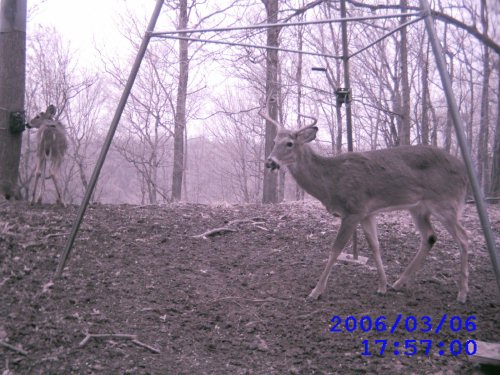|
Leaf River IR 3BU Scouting CameraWe've been using it now for a while and we are disapointed. The picture quality is poor in both daylight and darkness. You can see what the pictures look like here at the Leaf River IR picture quality page. I was under the impression that the pictures in the daylight would be normal color pictures but there are very few color pictures even in the daytime. You can set the camera on one of three different resolution settings. They are 1.3MP, 2.1MP and up to 4MP. I’m trying the 2.1MP setting first which should give us good picture quality that we can zoom in on and yet leave the pictures small enough to fit quite a few on a memory card. We have been dissapointed with the picture quality but it's not the resolution that is the problem. The Leaf River IR 3BU Scouting Camera operates on 4D and 3C batteries just like the older 1BU model that we tested a year ago. This number of batteries is still more than the rest of the units that we have tested. Fresh batteries lasted for about 5 months and there were not a lot of pictures taken over this time period as compared to the number of pictures that our other cameras take. We recently started using rechargeable batteries in this cam. So far we have gotten good life out of these batteries. I'll keep using these batteries rather than continue to buy the alkaline batteries. The set-up and operation of this unit is not real difficult but I do not like the buttons and the labels that are on them. I have to have the instructions or I would be lost, it is not self-explanatory at all. I’ll keep the directions on hand. There is also an instructional DVD included but to be honest it didn't help a lot. The operation of this cam has not grown on me over the months. It is more confusing and I find myself not wanting to change any settings or try to use the LCD screen to view pictures. We have tested the power up time against four other cameras by putting them on a telephone pole, walking in front of them and comparing where we were when the cams took our picture. The Leaf River IR 3BU digital scouting camera was faster than the Penn's Woods, and slower than the Cuddeback, EagleEye and Wildview. The Leaf River IR 3BU Scouting Camera has both a fast and battery save trigger time. The faster power up time will, of course, use the batteries up faster. The information with the unit states that it has been redesigned to pick up movement quicker. This is true, but not to a great degree. The 3BU comes with a strap to attach it to a tree and a bar to lock the camera closed. The lock is not provided. When the bar is locked, the camera is not locked to the tree; it just locks the camera case closed. We use the strap, which is easy to use but the unit would still be easy to walk off with. The 3BU also has holes that you could put a Python cable through to lock the game camera to a tree. The camera has 16MB of internal memory and will hold from 10 to 50 pictures depending on the resolution. There is also a card slot for a Compact Flash card, which we use. The Leaf River IR 3BU Scouting Camera comes with a USB cable to connect it to a PC and an RCA cable to connect to a TV to view the pictures. This unit, as opposed to the 1BU, has a 1.6 inch LCD screen to view pictures and settings. Initially I was not able to get the viewing screen to work, but after e-mailing the manufacturer I was able to get it to work using their directions. I might not be the sharpest stick in the box but I can't find these same directions in the instruction booklet that comes with the game camera. Time delay between pictures can be set for nine different time delays ranging from 1 to 90 minutes. I like to have a delay less than 1 minute for trails and food plots but these delays are acceptable. There is also a quick shot feature that forces the camera to take up to two additional pictures after first being triggered some 20 to 30 seconds apart. The Leaf River IR 3BU Scouting Camera has the capability of taking video clips in varying lengths. Unlike the units that use a flash this one will take videos at night using the infrared light.

|
